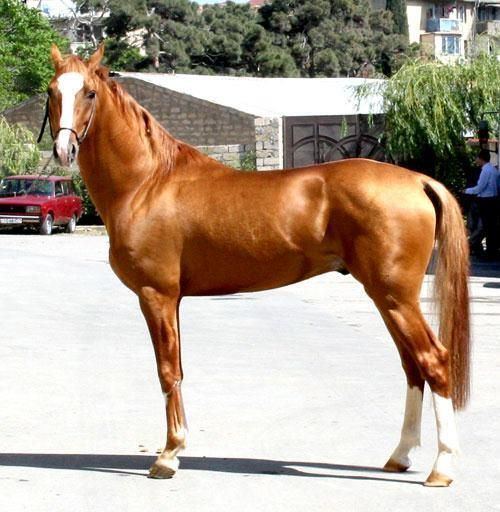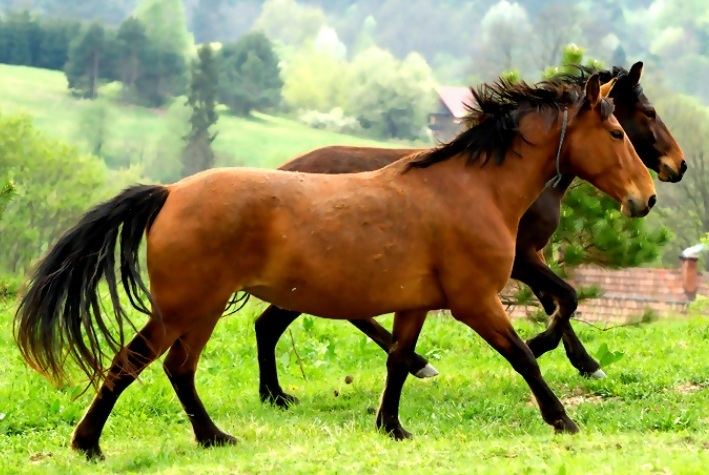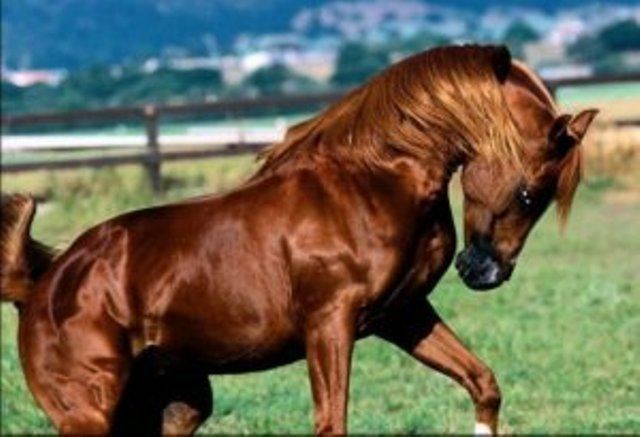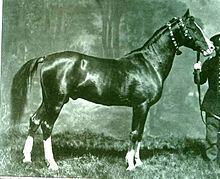Scientific name Equus ferus caballus | Rank Breed | |
 | ||
Distinguishing features stands between 14 and 15 hands high. Similar | ||
The Karabakh horse (Armenian: Ղարաբաղի ձի, Azerbaijani: Qarabağ atı), also known as Karabakh or Karabakhskaya in Russian, is a mountain-steppe racing and riding horse. It is named after the geographic region where the horse was originally developed, Karabakh in the Southern Caucasus, an area that is de jure part of Azerbaijan but the highland part of which is currently under the control of the Nagorno Karabakh Republic. The breed is noted for its good temper and speed. For example, in 2004 a Karabakh horse named Kishmish from the Agdam stud in Azerbaijan set a speed record by running 1000 metres in 1 minute 9 seconds, and 1600 metres in 1 minute, 52 seconds.
Contents

The breed is thought to be a cross-breeding of Akhal-Teke, Persian, Kabarda, Turkoman, and Arabian horse. It also influenced the development of the Russian Don horse in the 19th century. At present, the Karabakh is bred mainly in Azerbaijan's Shaki region. Currently the breed numbers are below 1,000 and it is threatened with extinction.

Karabakh horse lachin img 0364
Breed characteristics
The breed is hardy, strong, tough, and sure-footed.

The horse is not large: 14–15 hands (56–60 inches, 142–152 cm) They have small, clean-cut heads, a straight profile with broad foreheads, and nostrils very capable of dilation. The neck is set high, average in length, muscular and elegant. They have compact bodies with well defined and developed muscles. The shoulders are often quite upright. The horses have a deep chest, a sloping croup, and long, fine, but very strong legs, although the joints are small. The horses are narrow, not very deep through the girth, due to the Akhal-Teke influence.

Their skin is thin and soft with gleaming hair. The main colors of the breed are chestnut and bay, with characteristic golden tint of the breed. They can also be gray. Rarely they can be Palomino or Buckskin. White markings are allowed.
As well as being fast and agile, the Karabakh horse is reputed to have a good endurance and loyalty to master.
Breed history
The Karabakh has close links to the Akhal-Teke, which is bred in Turkmenistan, Central Asia, and the Turkoman horse, which is bred in Iran. Some historians believe that in ancient times these horses were of the same strain and had significant influence on the development of the Arabian breed. The Karabakh region was long renowned for the quality of its horses. The classical historian Strabo describes its province of "Orchistene" as supplying the kingdom with the "most cavalry." Some historical sources mention that during the Arab invasions of Arran in the eighth-ninth centuries tens of thousands of horses with golden-chestnut coloring, characteristic for Karabakhs, were taken by the conquerors.
The breed attained its current shape and characteristics during the 18th and 19th centuries. There is some evidence that Ibrahim-Khalil (1763-1806), khan of the Karabakh khanate, possessed a horse herd numbering 3,000-4,000, mostly of the Karabakh breed. From the 19th century onwards this horse breed became increasingly popular in Europe. Thus, in one of the first big sales in 1823, an English company purchased 60 pure Karabakh mares from Mehdi-Kulu Khan, the last ruler of the Karabakh khanate. Karabakh numbers were initially hurt in 1826 during the Russo-Iranian war, but the breed remained intact. After Mehdi-Kulu Khan, his daughter Khurshidbanu Natavan took care of the breed. In a series of successes her Karabakh stallions received the highest awards in various exhibitions during the 19th century. As a result, the Karabakh horse Khan received a silver medal at an international show in Paris in 1867. At the second All-Russian exhibition in 1869, the Karabakh horse Meymun also won a silver medal, another stallion, Tokmak, won bronze. A third, Alyetmez (pictured), received a certificate and was made a stud-horse in the Russian Imperial stud.
The Karabakh played an important role in the formation of the Russian Don horse breed. In 1836 the heir of the Russian general Valerian Madatov sold all his horses, including 200 Karabakh mares, to a horse-breeder in the Don region. These Karabakhs were used for improving the Russian Dons' characteristics into the 20th century.
In the early 20th century the Karabakhs sharply decreased in numbers again, mostly because of civil and ethnic wars in the Caucasus in general and in the Karabakh region in particular. The horse breeding enterprise established by the Karabakh khans and developed by their heirs was destroyed in 1905. The offspring of many pure-blood Karabakhs became a mix of Karabakh and other, non-pure, horses, resulting in changes to some characteristics, such a reduction in size.
In 1949 the breed was revived at the Agdam stud in Azerbaijan, which brought together the most characteristic Karabakhs. In 1956 a Karabakh stallion named Zaman, along with an Akhal-Teke named Mele-Kush was presented by the Soviet government to the Queen of Britain, Elizabeth II.
The Karabakh horse breed suffered another setback during the Nagorno-Karabakh war. In the days before the capture of Agdam by the Armenian forces in 1993 most of the Karabakh horses were moved from the Agdam stud. These horses are currently bred in winter pastures in the lowland Karabakh plains between Barda and Agjabadi provinces.
In popular culture
The Karabakh horse is the national animal of Azerbaijan and the official symbol of Agdam and Shaki region. The horse is of great cultural importance to the people of Azerbaijan and they are featured from literature to postage stamps.
In 2012, the breed took part in Royal Windsor Horse Show to perform at the Diamond Jubilee of Elizabeth II celebrations.
In 2013 Chovqan, a traditional Karabakh horse-riding game in the Republic of Azerbaijan was inscribed on the List of Intangible Cultural Heritage in Need of Urgent Safeguarding.
